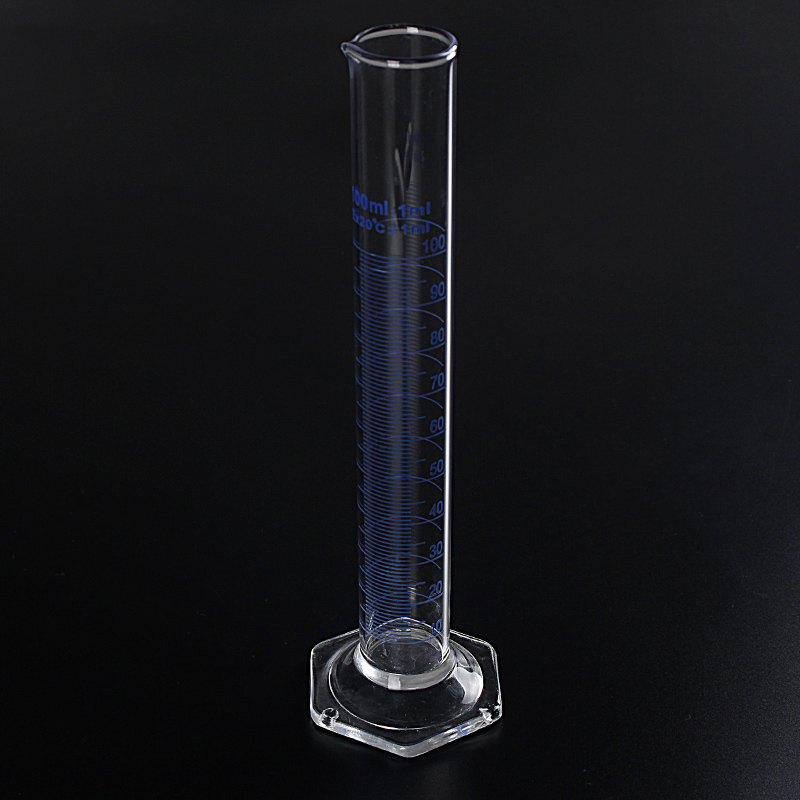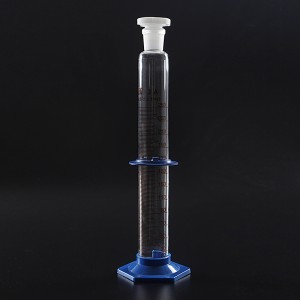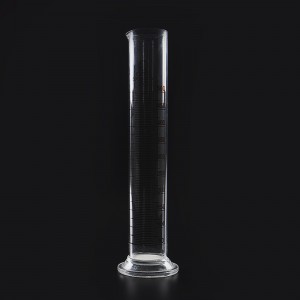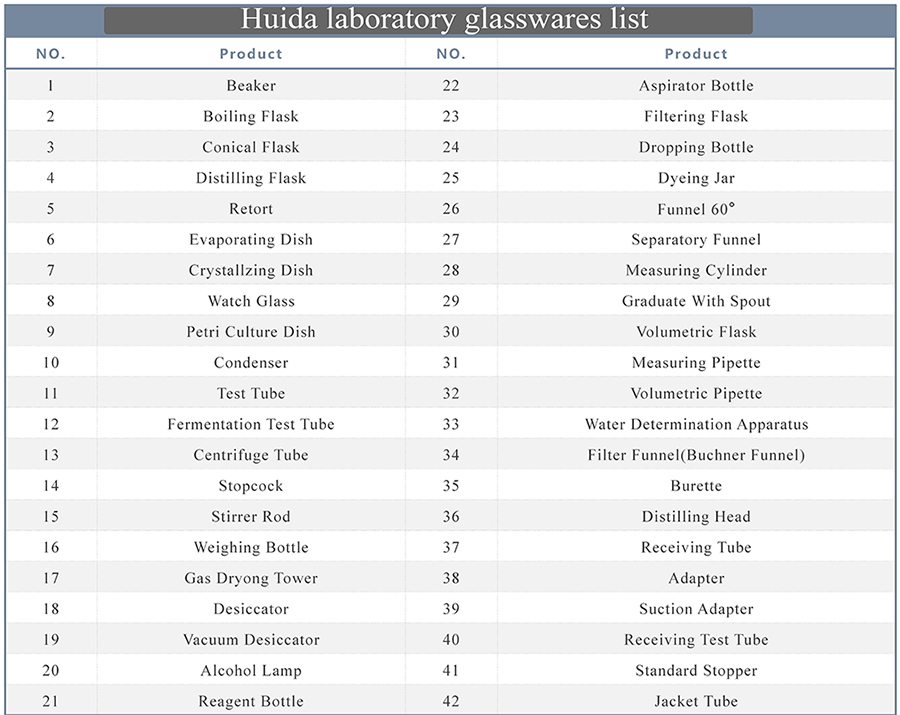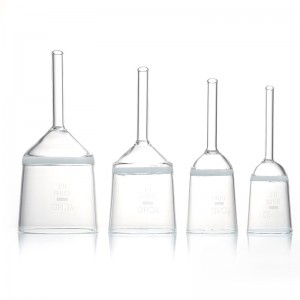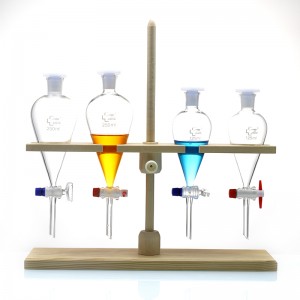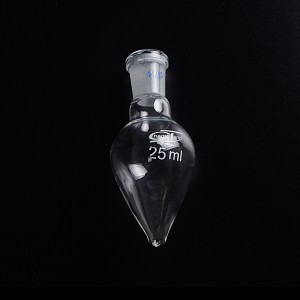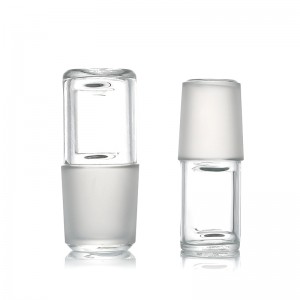Welcome To Huida
10ml 25ml 50ml 100ml 250ml 500ml 1000ml Transparent Graduated Glass Measuring Cylinder
Measuring Cylinder Introduction
A measuring cylinder (graduated cylinder, graduated glass) is a glass instrument used to measure liquids. A measuring cylinder is an instrument for measuring the volume of a liquid. The measuring cylinder is a vertical cylindrical shape with a mouth on one side of the upper edge for easy pouring. There are wide feet at the lower part to maintain stability. The volume range is engraved on the cylinder wall for users to read the volume.
The specification is expressed by the capacity of the energy degree (ml), and the outer wall scale is in ml. The larger the graduated cylinder, the thicker the pipe diameter and the smaller the degree, the greater the reading error caused by the deviation of the line of sight. Therefore, in the experiment, the smallest measuring cylinder that can be measured at one time should be selected as far as possible according to the volume of the solution taken.
Product Specification
|
1601H |
Measuring Cylinder with glass hexagonal base, with graduation |
||
|
Capacity(ml) |
graduation(ml) |
Capacity tolerance(±ml) |
Height(mm) |
|
5 |
0.1 |
0.1 |
115 |
|
10 |
0.2 |
0.2 |
135 |
|
25 |
0.5 |
0.5 |
160 |
|
50 |
1 |
0.5 |
195 |
|
100 |
1 |
1 |
240 |
|
250 |
2 |
2 |
320 |
|
500 |
5 |
5 |
380 |
|
1000 |
10 |
10 |
465 |
|
2000 |
20 |
20 |
565 |
|
1601 |
Measuring Cylinder with spout and graduations, with glass round base |
||
|
Capacity(ml) |
graduation(ml) |
Capacity tolerance(±ml) |
Height(mm) |
|
5 |
0.1 |
0.1 |
110 |
|
10 |
0.2 |
0.2 |
135 |
|
25 |
0.5 |
0.5 |
160 |
|
50 |
1 |
0.5 |
195 |
|
100 |
1 |
1 |
250 |
|
250 |
2or5 |
2 |
300 |
|
500 |
5 |
5 |
350 |
|
1000 |
10 |
10 |
430 |
|
2000 |
20 |
20 |
500 |
|
1601P |
Measuring Cylinder with plastic hexagonal base, with graduation |
||
|
Capacity(ml) |
graduation(ml) |
Capacity tolerance(±ml) |
Height(mm) |
|
5 |
0.1 |
0.1 |
110 |
|
10 |
0.2 |
0.2 |
135 |
|
25 |
0.5 |
0.5 |
160 |
|
50 |
1 |
0.5 |
195 |
|
100 |
1 |
1 |
250 |
|
250 |
2or5 |
2 |
300 |
|
500 |
5 |
5 |
350 |
|
1000 |
10 |
10 |
430 |
|
2000 |
20 |
20 |
500 |
|
1603 |
Measuring Cylinder With graduations and ground–in glass stopper |
||
|
Capacity(ml) |
graduation(ml) |
Capacity tolerance(±ml) |
Height(mm) |
|
10 |
0.2 |
0.1 |
150 |
|
25 |
0.5 |
0.25 |
150 |
|
50 |
1 |
0.25 |
215 |
|
100 |
1 |
0.5 |
270 |
|
250 |
2or5 |
1 |
320 |
|
500 |
5 |
2.5 |
380 |
|
1000 |
10 |
5 |
460 |
|
2000 |
20 |
10 |
530 |
Pay attention to the following items when using the measuring cylinder
1. The measuring cylinder cannot be used as a reaction vessel.
2. The measuring cylinder cannot be heated.
3. The measuring cylinder cannot dilute concentrated acid and alkali.
4. The measuring cylinder cannot store medicine.
5. The graduated cylinder is not capable of taking hot solution.
6. The measuring cylinder cannot be cleaned with decontamination powder to avoid scratching the scale.
Q&A about graduated cylinders
1. How to pour liquid into the graduated cylinder?
When injecting liquid into the vector cylinder, hold the measuring cylinder with your left hand and tilt the measuring cylinder slightly, and hold the reagent bottle in your right hand so that the mouth of the measuring cylinder is close to the mouth of the measuring cylinder, so that the liquid flows in slowly. When the amount to be injected is slightly less than the required amount, put the measuring cylinder flat, and use a rubber-tip dropper to drip to the required amount.
2. Where should the scale of the graduated cylinder go?
The graduated cylinder does not have a “0″ scale, and generally the starting scale is 1/10 of the total volume. Because the line of sight has to pass through two layers of glass and liquid, if the liquid is turbid, the scale will not be clear, and the scale numbers are not pleasing to the eye. Therefore, the scale faces the talents.
3. When is the volume of liquid taken out?
After injecting the liquid, wait 1 to 2 minutes to allow the liquid attached to the inner wall to flow down, and then read the scale value. Otherwise, the value read is too small.
4. How to read the volume of liquid taken?
The measuring cylinder should be placed on a flat table. When observing the scale, keep the line of sight and the lowest part of the concave liquid surface of the liquid in the measuring cylinder level, and then read the volume of the liquid taken. Otherwise, the reading will be high or low.
5. Can the measuring cylinder heat up or measure overheated liquid?
The scale on the measuring cylinder refers to the volume when the temperature is at 20°C. As the temperature rises, the graduated cylinder thermally expands and its volume increases. It can be seen that the graduated cylinder cannot be heated, nor can it be used to measure overheated liquid, let alone conduct chemical reactions or prepare solutions in the graduated cylinder.
6. Do I need to flush the measuring cylinder with water after pouring liquid from the measuring cylinder?
It depends on the specific situation. If it is only to make the measurement accurate, there is no need to flush the measuring cylinder with water, because the residual liquid has been taken into consideration when manufacturing the measuring cylinder. On the contrary, if flushing, the volume taken will be too large. If you want to measure another liquid with the same measuring cylinder, you must rinse it with water to prevent contamination by impurities.
7. Regarding the question of looking up and down on the measuring cylinder
When looking at the volume of the measuring cylinder, it is looking at the center point of the water surface.
When looking down, the line of sight is diagonally downward. The intersection of the line of sight and the cylinder wall is on the water surface, so the data read is higher, and the actual measured solution value is lower. Looking up is the line of sight obliquely upwards. The intersection of the line of sight and the wall of the cylinder is below the water surface, so the data read is low, and the actual measured solution value is high.
8. When does the scale of the graduated cylinder start?
The lowest scale is usually one-tenth of the largest scale. For example, the maximum scale is 1mL for the standard minimum scale of a 10mL graduated cylinder, and the minimum scale for a 500mL graduated cylinder should be 50mL.
The following is a list of Huida laboratory glassware, if you are also interested in the following other products, please feel free to contact us, we will reply you as soon as possible.
Scope Of Application


Send your message to us:
Products categories
Why Choose Us
Yancheng Huida Glass Instrument Co., Ltd. is the experienced manufacturer, mainly produces high quality laboratory glassware and other general labware. The band of “YCHD” boiling glass series and volumetric measuring instruments are well-known all over the world.

